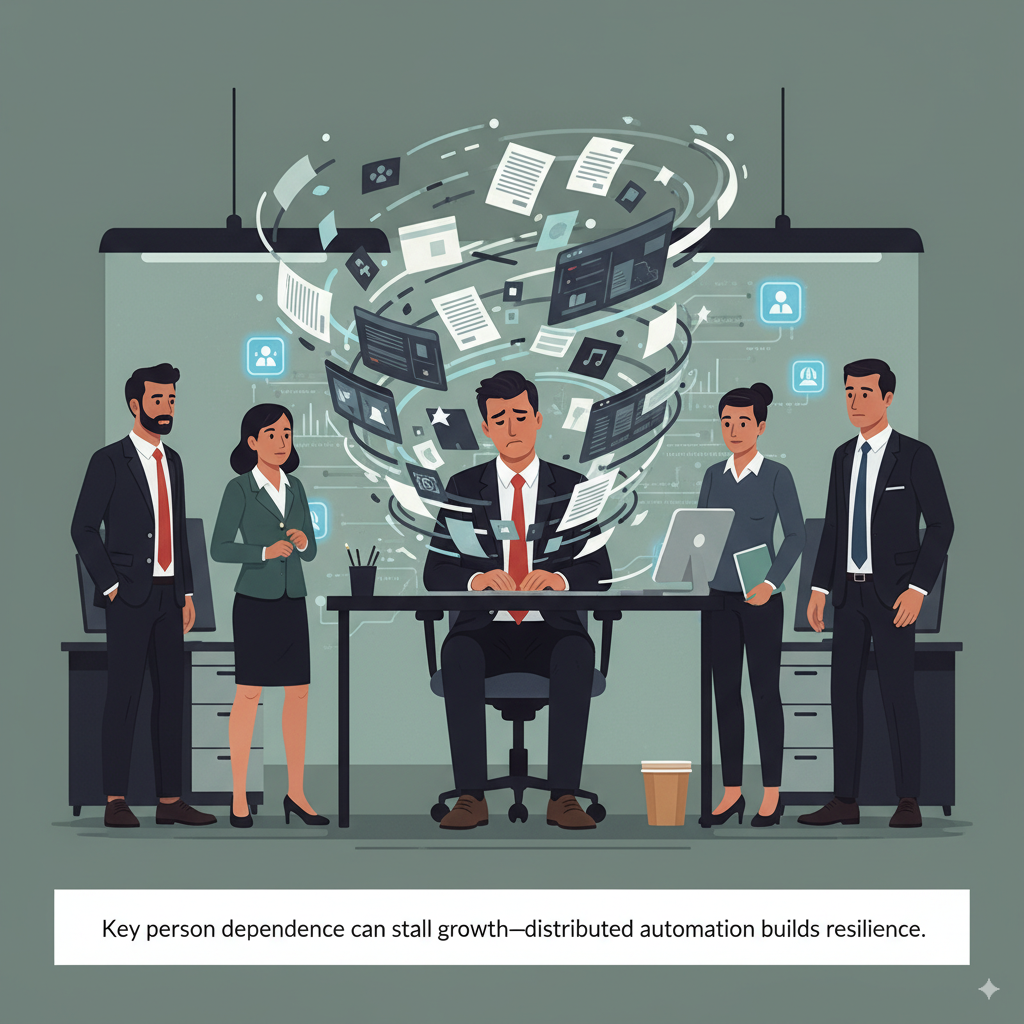Introduction — Why Relying on One Key Person Is a Silent Risk
What happens if your business hinges on one person? What if they walk out tomorrow? Or worse, what if they burn out before you notice the warning signs?
This is the hidden danger known as key person risk. In small businesses, where resources are lean, it is common for one individual—often the founder, office manager, or lead technician—to carry critical responsibilities. But centralizing too much knowledge and authority in one place makes the business fragile.
This post unpacks the operational, financial, and automation risks of relying too heavily on one person—and how to guard against them with Small Business Automation.
What Happens If That Person Leaves?
Business Continuity at Stake
When a key employee holds everything in their head, continuity collapses if they exit.
- Workflows grind to a halt because no one else knows the process.
- Customer relationships suffer if contact histories are undocumented in a CRM.
- Projects stall as others scramble to fill the knowledge gap.
The U.S. Small Business Administration notes that loss of a primary operator is one of the top reasons for small business failure, often leading to closure within months.

Financial and Legal Risks
Dependence on one person also affects financing and compliance.
- Lenders and insurers classify key person dependence as a liability.
- Legal exposure grows if regulatory knowledge is not written down.
- Even well-meaning mistakes (like missed filings) can bring penalties.
The Automation Angle — How Over-Reliance Blocks Efficiency
Lost Opportunities in Small Business Automation
When one person acts as the gatekeeper, automation stalls. They may resist adopting new systems, or simply lack time to configure them. As a result, opportunities to connect accounting, CRM, scheduling, and communication tools slip away.
Yet automation thrives on distribution. Integration spreads data across platforms, creating resilience that does not depend on one memory or inbox.

The Bottleneck Effect
Centralizing control creates predictable bottlenecks:
- Approvals wait for one signature.
- Passwords are known by only one person.
- Clients delay decisions until the “go-to” returns.
Instead of scaling, the business gets stuck in single-threaded workflows.
Secondary Effects of Key Person Risk
Burnout and Morale
The overloaded person becomes exhausted, increasing turnover risk. Others avoid responsibility, assuming the “expert” will handle it. This dynamic erodes morale and builds resentment across the team.
Security Vulnerabilities
Shortcuts creep in. Shared logins, undocumented workflows, and informal handoffs become standard practice. Without a Single Source of Truth, errors multiply and access risks grow.
Growth Ceiling
A business tied to one person’s bandwidth cannot scale. Growth requires repeatable systems. Without documented processes and micro office automation, the ceiling arrives quickly: survival mode instead of expansion.
Practical Safeguards for Small Businesses
The good news: key person risk is manageable. Safeguards are simple, though often neglected until crisis hits.
- Document processes: Create plain-English SOPs anyone can follow.
- Adopt workflow automation: Offload repetitive tasks to reliable systems.
- Invest in integration: Connect CRM, accounting, and communications into one flow.
- Cross-train staff: Ensure no task belongs to just one person.
- Plan for continuity: Secure insurance and contingency plans.

Conclusion — Building Resilient Businesses
Key person risk is not inevitable. By documenting, sharing, and automating processes, small businesses protect themselves from disruption.
Business Automation is more than efficiency—it is resilience. Systems that capture workflows free businesses from dependence on single individuals and open the path to sustainable growth.
Next Step: Explore the Small Business Automation Hub for strategies, or dive into the Integration Patterns Library to see practical examples. For call workflows, see the Call Intake Playbook.
References
- U.S. Small Business Administration – Business continuity resources.
- Investopedia: Key Person Risk.
- Harvard Business Review – Resilience in small organizations.
- Brian’s principle: Single Source of Truth (Knowledge Base Reference).
